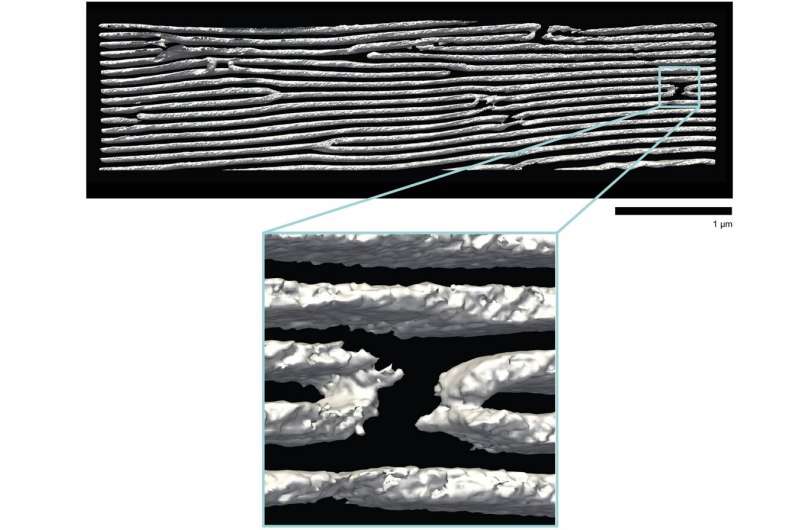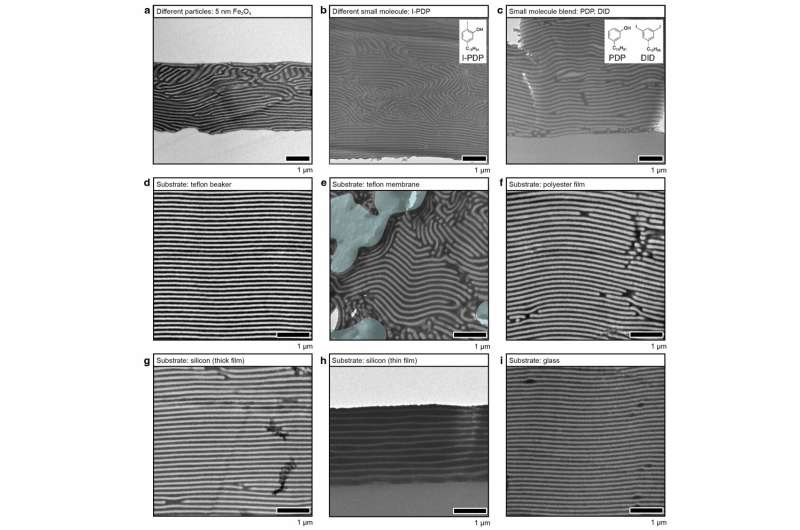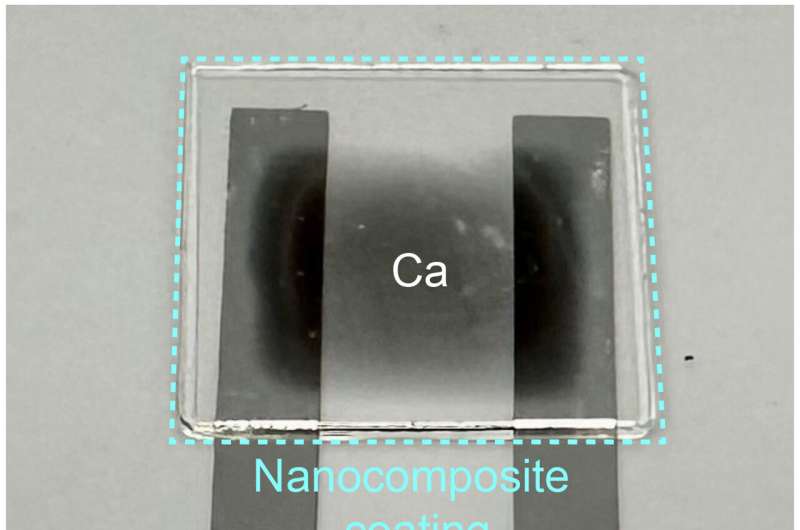This article has been reviewed according to Science X's editorial process and policies. Editors have highlighted the following attributes while ensuring the content's credibility:
fact-checked
peer-reviewed publication
trusted source
proofread
Scaling up nano for sustainable manufacturing with self-assembling nanosheets

A new self-assembling nanosheet could radically accelerate the development of functional and sustainable nanomaterials for electronics, energy storage, health and safety, and more.
Developed by a team led by Lawrence Berkeley National Laboratory (Berkeley Lab), the new self-assembling nanosheet could significantly extend the shelf life of consumer products. And because the new material is recyclable, it could also enable a sustainable manufacturing approach that keeps single-use packaging and electronics out of landfills.
The team is the first to successfully develop a multipurpose, high-performance barrier material from self-assembling nanosheets. The breakthrough was reported in Nature.
"Our work overcomes a longstanding hurdle in nanoscience—scaling up nanomaterial synthesis into useful materials for manufacturing and commercial applications," said Ting Xu, the principal investigator who led the study. "It's really exciting because this has been decades in the making."
Xu is a faculty senior scientist in Berkeley Lab's Materials Sciences Division, and a professor of chemistry and materials science and engineering at UC Berkeley.
One challenge in harvesting nanoscience to create functional materials is that many small pieces need to come together so that the nanomaterial can grow large enough to be useful. While stacking nanosheets is one of the simplest ways to grow nanomaterials into a product, "stacking defects"—gaps between the nanosheets—are unavoidable when working with existing nanosheets or nanoplatelets.
"If you visualize building a 3D structure from thin, flat tiles, you'll have layers up the height of the structure, but you'll also have gaps throughout each layer wherever two tiles meet," said first author Emma Vargo, a former graduate student researcher in the Xu group and now a postdoctoral scholar in Berkeley Lab's Materials Sciences Division. "It's tempting to reduce the number of gaps by making the tiles bigger, but they become harder to work with," Vargo said.

The new nanosheet material overcomes the problem of stacking defects by skipping the serial stacked sheet approach altogether. Instead, the team mixed blends of materials that are known to self-assemble into small particles with alternating layers of the component materials, suspended in a solvent. To design the system, the researchers used complex blends of nanoparticles, small molecules, and block copolymer-based supramolecules, all of which are commercially available.
Experiments at Oak Ridge National Laboratory's Spallation Neutron Source helped the researchers understand the early, coarse stages of the blends' self-assembly.
As the solvent evaporates, the small particles coalesce and spontaneously organize, coarsely templating layers, and then solidify into dense nanosheets. In this way, the ordered layers form simultaneously rather than being stacked individually in a serial process. The small pieces only need to move short distances to get organized and close gaps, avoiding the problems of moving larger "tiles" and the inevitable gaps between them.
From a previous study led by Xu, the researchers knew that combining nanocomposite blends containing multiple "building blocks" of various sizes and chemistries, including complex polymers and nanoparticles, would not only adapt to impurities but also unlock a system's entropy, the inherent disorder in mixtures of materials that Xu's group harnessed to distribute the material's building blocks.
The new study builds on this earlier work. The researchers predicted that the complex blend used for the current study would have two ideal properties: In addition to having high entropy to drive the self-assembly of a stack of hundreds of nanosheets formed simultaneously, they also expected that the new nanosheet system would be minimally affected by different surface chemistries. This, they reasoned, would allow the same blend to form a protective barrier on various surfaces, such as the glass screen of an electronic device, or a polyester mask.
Demonstrating a new 2D nanosheet's ease of self-assembly and high performance
To test the material's performance as a barrier coating in several different applications, the researchers enlisted the help of some of the nation's best research facilities.

During experiments at Argonne National Laboratory's Advanced Photon Source, the researchers mapped out how each component comes together, and quantified their mobilities and the manner in which each component moves around to grow a functional material.
Based on these quantitative studies, the researchers fabricated barrier coatings by applying a dilute solution of polymers, organic small molecules, and nanoparticles to various substrates—a Teflon beaker and membrane, polyester film, thick and thin silicon films, glass, and even a prototype of a microelectronic device—and then controlling the rate of film formation.
Transmission electron microscope experiments at Berkeley Lab's Molecular Foundry show that by the time the solvent had evaporated, a highly ordered layered structure of more than 200 stacked nanosheets with very low defect density had self-assembled on the substrates. The researchers also made each nanosheet 100 nanometers thick with few holes and gaps, which makes the material particularly effective at preventing the passage of water vapor, volatile organic compounds, and electrons, Vargo said.
Other experiments at the Molecular Foundry showed that the material has great potential as a dielectric, an insulating "electron barrier" material commonly used in capacitors for energy storage and computing applications.
In collaboration with researchers in Berkeley Lab's Energy Technologies Area, Xu and team demonstrated that when the material is used to coat porous Teflon membranes (a common material used to make protective face masks), it is highly effective in filtering out volatile organic compounds that can compromise indoor air quality.
In a final experiment in the Xu lab, the researchers showed that the material can be redissolved and recast to produce a fresh barrier coating.
Now that they've successfully demonstrated how to easily synthesize a versatile, functional material for various industrial applications from a single nanomaterial, the researchers plan to finetune the material's recyclability and add color tunability (it currently comes in blue) to its repertoire.
More information: Ting Xu, Functional composites by programming entropy-driven nanosheet growth, Nature (2023). DOI: 10.1038/s41586-023-06660-x. www.nature.com/articles/s41586-023-06660-x
Journal information: Nature
Provided by Lawrence Berkeley National Laboratory



















